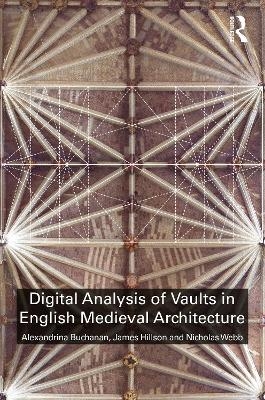
Digital Analysis of Vaults in English Medieval Architecture
Routledge (Verlag)
978-1-138-54132-0 (ISBN)
Medieval churches are one of the most remarkable creative and technical achievements in architectural history. The complex vaults spanning their vast interiors have fascinated both visitors and worshippers alike for over 900 years, prompting many to ask: ‘How did they do that?’ Yet very few original texts or drawings survive to explain the processes behind their design or construction.
This book presents a ground-breaking new approach for analysing medieval vaulting using advanced digital technologies. Focusing on the intricately patterned rib vaulting of thirteenth and fourteenth century England, the authors re-examine a series of key sites within the history of Romanesque and Gothic Architecture, using extensive digital surveys to examine the geometries of the vaults and provide new insights into the design and construction practices of medieval masons. From the simple surfaces of eleventh-century groin vaults to the gravity-defying pendant vaults of the sixteenth century, they explore a wide range of questions including: How were medieval vaults conceived and constructed? How were ideas transferred between sites? What factors led to innovations? How can digital methods be used to enhance our understanding of medieval architectural design?
Featuring over 200 high quality illustrations that bring the material and the methods used to life, Digital Analysis of Vaults in English Medieval Architecture is ideal reading for students, researchers and anyone with an interest in medieval architecture, construction history, architectural history and design, medieval geometry or digital heritage.
Alexandrina Buchanan is an archivist and architectural historian in the Department of History at the University of Liverpool. She specialises in the study of the material past, both archival and architectural, with a particular interest in the history and historiography of medieval architecture including vaults. James Hillson is an art historian who worked as Postdoctoral Research Associate on the Tracing the Past: English Medieval Vaults project at the University of Liverpool. He specialises in the study of architectural design practices and international artistic exchange in Northwestern Europe during the twelfth to fourteenth centuries. Nicholas Webb is an architect and lecturer at the Liverpool School of Architecture. His research focuses on the application of digital tools and techniques to enhance our understanding of historic works of architecture, particularly methods enabling new information that would not have been possible in a pre-digital context.
Introduction 1. Groins and ribs Case study 1: Norton Priory Case study 2: Gloucester Cathedral Digital diary 1: surveying techniques 2. Experiments with ribs Case study 3: Lincoln Cathedral Case study 4: Chester Cathedral Case study 5: Ely Cathedral Digital diary 2: rib tracing 3. Plans Case study 6: Wells Cathedral Case study 7: Ottery St Mary Digital diary 3: orthographic representations 4. Curves Case study 8: St Mary’s, Nantwich Case study 9: Norwich Cathedral Digital diary 4: generative design tools 5. Stonecutting Case study 10: Exeter Cathedral Case study 11: Westminster Abbey Digital diary 5: detailed analysis and 3D modelling 6. Webs Case study 12: Pershore Abbey Case study 13: Tewkesbury Abbey Digital diary 6: studying webbing Conclusions Bibliography Glossary Index
| Erscheinungsdatum | 02.08.2021 |
|---|---|
| Zusatzinfo | 9 Tables, black and white; 117 Line drawings, black and white; 94 Halftones, black and white; 211 Illustrations, black and white |
| Verlagsort | London |
| Sprache | englisch |
| Maße | 156 x 234 mm |
| Gewicht | 625 g |
| Themenwelt | Reisen ► Reiseführer |
| Geschichte ► Allgemeine Geschichte ► Mittelalter | |
| Technik ► Architektur | |
| ISBN-10 | 1-138-54132-X / 113854132X |
| ISBN-13 | 978-1-138-54132-0 / 9781138541320 |
| Zustand | Neuware |
| Haben Sie eine Frage zum Produkt? |
aus dem Bereich


